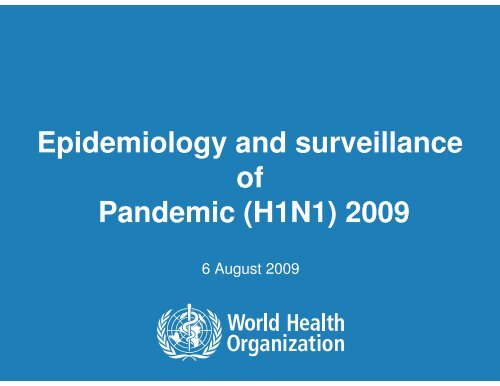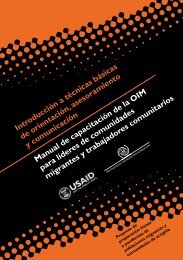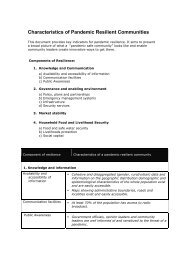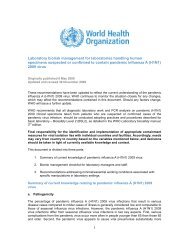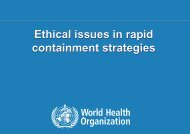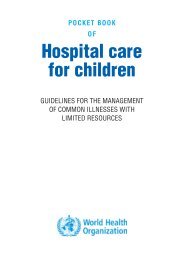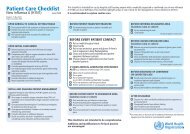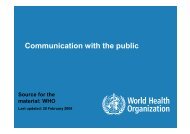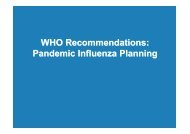Epidemiology and surveillance of Pandemic (H1N1) 2009
Epidemiology and surveillance of Pandemic (H1N1) 2009
Epidemiology and surveillance of Pandemic (H1N1) 2009
You also want an ePaper? Increase the reach of your titles
YUMPU automatically turns print PDFs into web optimized ePapers that Google loves.
<strong>Epidemiology</strong> <strong>and</strong> <strong>surveillance</strong><br />
<strong>of</strong><br />
P<strong>and</strong>emic (<strong>H1N1</strong>) <strong>2009</strong><br />
6 August <strong>2009</strong>
Introduction<br />
April <strong>2009</strong>: WHO received reports <strong>of</strong> sustained person to<br />
person transmission with a new influenza A (<strong>H1N1</strong>) virus in<br />
Mexico <strong>and</strong> USA<br />
Virus currently spread in all regions<br />
Current alert level: Phase 6<br />
Group <strong>of</strong> experts developed advice based on available<br />
information on influenza A (<strong>H1N1</strong>), seasonal <strong>and</strong> avian<br />
H5N1 influenza virus<br />
2 |<br />
<strong>Epidemiology</strong> <strong>and</strong> <strong>surveillance</strong> <strong>of</strong> p<strong>and</strong>emic <strong>H1N1</strong> <strong>2009</strong> | August 6, <strong>2009</strong>
WHO P<strong>and</strong>emic Phases<br />
Phases 5 & 6 are based on geographic spread, not severity<br />
3 |<br />
<strong>Epidemiology</strong> <strong>and</strong> <strong>surveillance</strong> <strong>of</strong> p<strong>and</strong>emic <strong>H1N1</strong> <strong>2009</strong> | August 6, <strong>2009</strong>
<strong>Epidemiology</strong> <strong>of</strong><br />
P<strong>and</strong>emic (<strong>H1N1</strong>) <strong>2009</strong> Virus Infection (1)<br />
5-45 yrs <strong>of</strong> age most commonly affected<br />
Hospitalization <strong>and</strong> case/fatality in young adults higher<br />
than seasonal influenza<br />
Epidemiologic <strong>and</strong> serologic evidence for low<br />
susceptibility in older adults<br />
At risk groups: Pregnant women, people with chronic<br />
diseases <strong>and</strong> underlying health conditions, young<br />
children, people with immunosuppression<br />
4 |<br />
<strong>Epidemiology</strong> <strong>and</strong> <strong>surveillance</strong> <strong>of</strong> p<strong>and</strong>emic <strong>H1N1</strong> <strong>2009</strong> | August 6, <strong>2009</strong>
<strong>Epidemiology</strong> <strong>of</strong><br />
P<strong>and</strong>emic (<strong>H1N1</strong>) <strong>2009</strong> Virus Infection (2)<br />
Efficient, rapid person-person transmission<br />
International travel has facilitated geographical spread<br />
Cases have been reported in all regions.<br />
More cases in urban centers before wider geographical<br />
spread within the countries.<br />
Most countries reporting an increasing trend.<br />
Continued circulation outside <strong>of</strong> usual influenza season<br />
5 |<br />
<strong>Epidemiology</strong> <strong>and</strong> <strong>surveillance</strong> <strong>of</strong> p<strong>and</strong>emic <strong>H1N1</strong> <strong>2009</strong> | August 6, <strong>2009</strong>
Surveillance Guidance (1)<br />
(WHO new recommendations- 16 July <strong>2009</strong>)<br />
For countries not yet affected:<br />
Early Detection<br />
– The first confirmed p<strong>and</strong>emic (<strong>H1N1</strong>) <strong>2009</strong> virus infection<br />
detected in a country should be immediately reported by the IHR<br />
National Focal Point<br />
And afterwards:<br />
– Any changes in the epidemiological, virological or clinical<br />
presentation<br />
– Any unusual or unexpected public health events, e.g. clusters <strong>of</strong><br />
severe unexplained acute respiratory illness or unexplained<br />
deaths<br />
6 |<br />
<strong>Epidemiology</strong> <strong>and</strong> <strong>surveillance</strong> <strong>of</strong> p<strong>and</strong>emic <strong>H1N1</strong> <strong>2009</strong> | August 6, <strong>2009</strong>
Surveillance Guidance (2)<br />
Description <strong>and</strong> Assessment<br />
Describe the epidemiological <strong>and</strong> virological features <strong>of</strong><br />
cases to guide control <strong>and</strong> prevention activities<br />
Assess disease severity<br />
Laboratory testing priorities<br />
– confirming infection in new areas<br />
– Testing severe cases<br />
– Monitoring the co-circulation <strong>of</strong> p<strong>and</strong>emic (<strong>H1N1</strong>) <strong>2009</strong> virus<br />
<strong>and</strong> seasonal viruses<br />
7 |<br />
<strong>Epidemiology</strong> <strong>and</strong> <strong>surveillance</strong> <strong>of</strong> p<strong>and</strong>emic <strong>H1N1</strong> <strong>2009</strong> | August 6, <strong>2009</strong>
Surveillance Guidance (3)<br />
Continuous Monitoring<br />
Report data to allow tracking <strong>of</strong>:<br />
global geographical spread<br />
disease trend<br />
prevalence<br />
impact <strong>of</strong> the p<strong>and</strong>emic on health-care services<br />
changes in viral antigenicity <strong>and</strong> antiviral sensitivity<br />
deaths from acute respiratory disease.<br />
8 |<br />
<strong>Epidemiology</strong> <strong>and</strong> <strong>surveillance</strong> <strong>of</strong> p<strong>and</strong>emic <strong>H1N1</strong> <strong>2009</strong> | August 6, <strong>2009</strong>
Monitoring (1)<br />
Output Expected<br />
A composite picture <strong>of</strong> severity <strong>and</strong> transmission characteristics<br />
primarily based on local interpretation <strong>of</strong> data <strong>and</strong> investigations.<br />
A description <strong>of</strong> clinical presentation, course, complications, <strong>and</strong> risk<br />
factors<br />
Virologic data for strain selection <strong>and</strong> antiviral sensitivity assessment<br />
Numbers <strong>of</strong> cases, hospitalizations, <strong>and</strong> deaths<br />
– Reflects laboratory capacity as much as it does disease activity<br />
– In high dem<strong>and</strong> by the media<br />
9 |<br />
<strong>Epidemiology</strong> <strong>and</strong> <strong>surveillance</strong> <strong>of</strong> p<strong>and</strong>emic <strong>H1N1</strong> <strong>2009</strong> | August 6, <strong>2009</strong>
Monitoring (2)<br />
Key Related Decisions<br />
Target groups for intervention with vaccine or antivirals<br />
– Risk groups in need protection.<br />
– Target groups that might have greatest impact on transmission.<br />
Strain to use for vaccine.<br />
Which antivirals to use.<br />
Role <strong>of</strong> nonpharmaceutical interventions.<br />
Appropriate management practices<br />
10 |<br />
<strong>Epidemiology</strong> <strong>and</strong> <strong>surveillance</strong> <strong>of</strong> p<strong>and</strong>emic <strong>H1N1</strong> <strong>2009</strong> | August 6, <strong>2009</strong>


